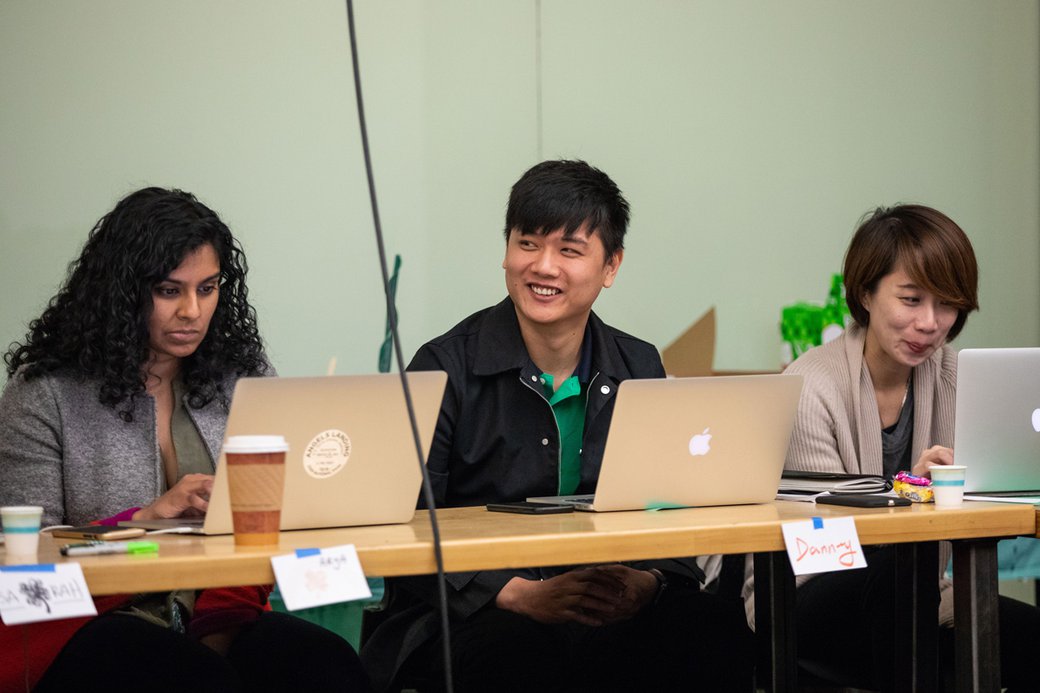
CCA’s MBA in Design Strategy early adopter of MURAL collaboration platform
In 2015, CCA became the first college to use MURAL in a hybrid business-design program.
In 2015 when David Chin enrolled in CCA’s MBA in Design Strategy program, his instructors introduced him to a cutting-edge visual collaboration software platform called MURAL. The platform, which functions as a kind of real-time digital whiteboard, is well suited to the kind of brainstorming, synthesis, and collaboration that’s fundamental to the program’s approach to innovation.
Career job at graduation
Thanks to Chin’s familiarity with the software and his CCA education, he landed a summer internship at MURAL last year and has since been hired full-time even as he completes his degree.
“In the San Francisco office, we’re primarily focused on customers and investors,” Chin says. “We’re working with large organizations to help innovate and optimize their team practices.
“We recently helped the innovation department at Salesforce create a process to facilitate design thinking exercises with their customers.”

About MURAL
MURAL was founded by Mariano Suarez-Battan in 2011. At the time, he was designing a video game and decided he’d need new software to better collaborate with his remote, interdisciplinary team.
The team decided to shift from creating the game to creating that software.
The idea of a virtual sticky note -- a flexible element that helps users crystallize and organize their thoughts -- is central to MURAL. Users can sort their ideas spatially, collaborate in real time, track changes, and see how ideas evolve.
Added value for DMBA program
In 2014, global design leader IDEO invited MURAL to participate in its Startup in Residence program, which helped Suarez-Battan and his colleagues simplify and refine the software.
It was at this time when MURAL was being incubated at IDEO, CCA DMBA associate chair Tim Smith got a demonstration of the software.
Smith realized MURAL could be a useful tool for preparing his students, 20 percent of which live outside the Bay Area, for future connected workplaces.
“We encourage students to learn through collaboration in small teams,” Smith says. “They meet for four full days each month. In between, they have weekly assignments and need robust tools to help them work together to develop project ideas, test hypotheses, and share the process steps and progress.”
Smith inquired what it would cost for DMBA students to license the software, and Suarez-Battan offered MURAL to the program for free in exchange for information about how the students are using it and how it could better meet their needs.
In 2015 CCA became the first college to use MURAL in a hybrid business-design program.
“CCA is readying a new breed that provides the combination of great experience design and business impact sustainability,” Suarez-Battan says. “We are happy to support the college in that journey.”
Integration is key
“Our teachers introduced [MURAL] to us as a tool we could use for brainstorming, for process, and to promote collaboration,” Chin recalls. Initially, he and other students adopted MURAL slowly, in part because they were accustomed to conventional software tools.
But by 2016, when Chin learned MURAL wanted a DMBA student to come on board for a summer internship, he considered the MURAL platform indispensable and decided to apply.
“I feel like MURAL has this higher mission of improving team practices and productivity,” Chin says.
He met with Suarez-Battan and landed the internship. He quickly made use of what -- and how -- he had been learning at CCA.
“In the DMBA program, we’re always using team charters and feedback sessions to make sure our teams are on the same page,” Chin says. “We get this all down in a visual way and we refer back to it as needed. It’s a high level of collaboration and it enables us to work effectively even when we’re not all in the same place.
“With MURAL we can go back to it at any time and move elements and edit them.”
The internship turned Chin into a MURAL evangelist, and he’s been advocating for its benefits among fellow students.
“I’ve seen how it empowers,” he says. “Often in meetings some people run the show and others fade into the background. But MURAL helps bring everyone forward; everyone’s there for a reason. Anyone can have a voice and become a project champion.”

David Allen Chin | MBA in Design Strategy
Internship leads to full-time position
After his internship, MURAL hired Chin as an MBA Design Strategy resident. It’s a full-time job, but the hours are flexible to accommodate his school schedule. He has continued to demonstrate his value to the company.
“I was able to connect my colleagues at MURAL with some alumni and previous professors from the MBA in Design Strategy program,” Chin says. “It occurred to me that there could be a mutually beneficial relationship.
“I approached it like a strategic endeavor -- talking with both sides, seeing that it could work for both sides, then bringing them together. For me it was more than introducing like-minded people; there’s now an ongoing relationship.
“It feels good to say that I was able to plant that seed and water it.”
Internship leads to full-time position
After his internship, MURAL hired Chin as an MBA Design Strategy resident. It’s a full-time job, but the hours are flexible to accommodate his school schedule. He has continued to demonstrate his value to the company.
“I was able to connect my colleagues at MURAL with some alumni and previous professors from the MBA in Design Strategy program,” Chin says. “It occurred to me that there could be a mutually beneficial relationship.
“I approached it like a strategic endeavor -- talking with both sides, seeing that it could work for both sides, then bringing them together. For me it was more than introducing like-minded people; there’s now an ongoing relationship.
“It feels good to say that I was able to plant that seed and water it.”
Designing the future of business
Chin’s time at MURAL has given him insight into how the MBA in Design Strategy program is designing the future of business.
“Design thinking is a huge part of the future of work -- I’m seeing it being introduced to corporate teams,” Chin says. “Design MBA students are becoming experts in that process in a way that’s adaptable to many different real-life situations.
“And we’re being prepared for situations where we’ll need to embrace ambiguity. This may be difficult for many professionals, but it’s normal for us, and because we’ve been successful in navigating uncertainty, we can still do our best work and trust each other and get to where we want to be.
“I’ve been embedded in the cultures of larger companies -- Microsoft, IBM, AT&T -- and I’m noticing that they’re starting to do stuff that the DMBA program has already been doing, such as preparing for remote working situations with distributed teams where people are working different hours.
“That was all new to me when I came to CCA, and now that I’m seeing these big companies doing the same thing, it sort of validates the DMBA program.
“For me, it starts with the human-centered approach that we’re learning in DMBA. Going to the stakeholders and finding out what they need and how they act now and what they’re looking for and how we can get them there using this remote collaboration device.”
DMBA faculty: extremely pleased
Smith says he and other leaders of the DMBA program are “extremely pleased” with MURAL because collaboration through visualization is such an integral part of the program.
Smith says: “MURAL has provided easy access for individual students, teams of students, and an entire class to use preloaded templates and build their own templates.
“Our instructors appreciate seeing the work product from each team as they embed various murals into the weekly assignments.
“I’m teaching the Business Models & Stakeholders course this semester and I have five teams of students, each using MURAL during the process of developing business model recommendations for real clients.”